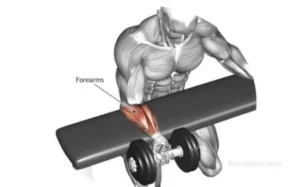Forearm dumbbell workouts: In the realm of fitness, the focus often falls on biceps, triceps, and chest workouts, while the forearms remain a neglected area. However, the significance of strong forearms goes beyond mere aesthetics. They play a crucial role in overall arm strength, grip power, and injury prevention.
Benefits of Strong Forearms
Enhanced Grip Strength
One of the primary advantages of well-developed forearms is the improvement in grip strength. Whether you’re an athlete, weightlifter, or simply someone who uses their hands frequently, a strong grip is invaluable.
Injury Prevention
Strong forearm dumbbell workouts contribute to joint stability, reducing the risk of injuries in both daily activities and intense workouts. This is particularly crucial for individuals involved in repetitive tasks or sports that involve gripping.
Improved Overall Arm Aesthetics
Well-defined forearms add a touch of symmetry and completeness to your arm muscles. When the forearms are proportionately developed, it enhances the overall aesthetic appeal of your arms.

Why Forearms Matter?
Beyond aesthetics, well-developed forearms offer a plethora of benefits:
- Grip Strength: Whether scaling mountains or mastering pull-ups, strong forearms ensure a firm hold on life’s challenges.
- Improved Performance: Enhanced forearm strength translates to better performance in sports like tennis, golf, and rock climbing.
- Injury Prevention: Strong forearms stabilize the wrist joint, reducing the risk of sprains and strains.
- Enhanced Aesthetics: Sculpted forearms add balance and definition to your upper body, completing the muscular tapestry.
Dumbbell Delights: Forearm-Focused Exercises
Now, let’s delve into the arsenal of dumbbell exercises that will turn your forearms into fortresses of power:
1. Hammer Curls:
- A classic for a reason, hammer curls target the brachioradialis, the muscle that runs along the outside of your forearm.
- Hold dumbbells with neutral grips (palms facing each other).
- Curl the weights towards your shoulders, squeezing at the peak.
- Perform 3 sets of 8-12 reps.
2. Wrist Curls:
- Isolate the wrist flexors and extensors for targeted development.
- Sit with elbows resting on your knees, palms facing up (forearm curls) or down (reverse curls).
- Curl your wrists upward or downward, squeezing at the top.
- Perform 3 sets of 12-15 reps for each variation.
3. Zottman Curls:
- This two-in-one exercise challenges both the biceps and forearms.
- Start with a hammer curl, raising the dumbbells towards your shoulders.
- At the peak, rotate your wrists so your palms face down (supinated grip).
- Slowly lower the weights in this reverse curl position.
- Perform 3 sets of 8-12 reps.
4. Wrist Rotations:
- Strengthen the rotator muscles for improved grip and dexterity.
- Hold dumbbells with palms facing down.
- Rotate your wrists outward and inward, controlling the movement throughout.
- Perform 2 sets of 12-15 reps for each direction.
5. Farmer’s Walk:
- Build overall grip strength and forearm dumbbell workouts endurance with this functional exercise.
- Hold dumbbells at your sides, palms facing inward.
- Walk for 30-60 seconds, maintaining good posture and core engagement.
- Repeat for 2-3 sets.

Beyond the Basics: Advanced Training Techniques
As your forearms adapt, consider these techniques to keep your workouts challenging:
- Drop Sets: After completing a set with a specific weight, immediately reduce the weight and perform another set to failure.
- Supersets: Pair a forearm exercise with another upper body or core exercise for a time-efficient and intense workout.
- Isometric Holds: Hold contractions without movement for specified durations (30-60 seconds) to build isometric strength.
Remember:
- Warm-up: Always begin with light cardio and dynamic stretches to prepare your forearms for action.
- Form Matters: Focus on proper technique over heavy weights to avoid injury and maximize muscle engagement.
- Listen to Your Body: Rest and recovery are crucial for growth. Allow sufficient rest between workouts and never push through pain.
Forge Your Future:
By incorporating these dumbbell exercises into your training routine, you’ll soon witness the emergence of powerful forearms. Remember, consistency is key. So, grab those dumbbells, unleash your inner grips, and watch your forearms evolve into functional and formidable tools for a stronger, more capable you.
Bonus Tip: For an extra forearm challenge, try hanging from a pull-up bar for increasing durations. This simple bodyweight exercise is a masterclass in grip and forearm engagement.
Choosing the Right Dumbbells
Weight Considerations
Selecting the appropriate dumbbell weight is essential. It should be challenging but manageable, allowing for proper form without sacrificing intensity. Beginners may start with lighter weights and gradually progress.
1. Start Light:
It’s tempting to grab the heaviest dumbbells in sight, but resist the urge! Forearm muscles are smaller than major muscle groups and require a gradual progression to avoid injury. Begin with weights you can comfortably use for 8-12 repetitions while maintaining proper form.
2. Find Your Sweet Spot:
The ideal weight lies between challenging your muscles and pushing them to failure with good form. If you can easily crank out 15+ reps, it’s time to bump up the weight. Conversely, if you struggle to complete 8 reps with proper technique, choose a lighter weight. Remember, you’re building strength and endurance, not testing your grip like a vice.
3. Progressive Overload:
To keep your forearms constantly adapting and growing, gradually increase the weight over time. Aim to add 2.5-5 pounds every few weeks, or switch to sets with higher rep ranges once you master the current weight. Remember, consistent progress, not ego lifting, is the key to long-term gains.
4. Listen to Your Body:
Pay attention to your body’s signals during and after workouts. If you experience pain or discomfort, reduce the weight or take a break. Pushing through pain can lead to injury and derail your progress. Listen to your body and choose weights that feel right, not weights that prove a point.
5. Variety is Key:
Don’t get stuck in a rut with the same weight for every exercise. Use a variety of dumbbells to target different aspects of your forearms. Lighter weights are perfect for high-repetition exercises like wrist curls, while heavier weights can be used for exercises like hammer curls and farmer’s walks.
Safety First:
- Always choose dumbbells with textured grips to prevent slipping.
- Use proper form to avoid injury. Don’t jerk or swing the weights; focus on controlled movements.
- Warm up before your workout and cool down afterward.
- Don’t be afraid to ask for help from a trainer or gym staff member if you’re unsure about the appropriate weight or exercise technique.
Remember, the right weight is the one that allows you to train safely and effectively. Choose wisely, listen to your body, and watch your forearms transform into powerful tools for a stronger, fitter you!
Grip Variations for Different Goals
Dumbbells offer an incredibly versatile tool for sculpting your physique, and your grip on them plays a crucial role in targeting specific muscle groups and achieving your fitness goals. Here’s a deep dive into different grip variations and how they influence your workout:
1. Neutral Grip:
- Palms facing each other, thumbs alongside the plates.
- Targets the brachioradialis, the muscle on the outer forearm, and biceps.
- Great for hammer curls, wrist curls, and Arnold presses.
- Promotes elbow joint stability and healthy wrist alignment.
2. Supinated Grip:
- Palms facing forward, thumbs wrapped around the plates.
- Targets the biceps primarily, with some secondary activation of the forearms.
- Ideal for bicep curls, preacher curls, and concentration curls.
- Provides a strong bicep contraction but can put stress on the elbow joint.
3. Pronated Grip:
- Palms facing down, thumbs wrapped around the plates.
- Targets the brachioradialis and the entire forearm extensor chain.
- Perfect for reverse curls, wrist extensions, and skull crushers.
- Builds grip strength and forearm size effectively.
4. Mixed Grip:
- One hand neutral, the other supinated.
- Offers a unique challenge for core stability and anti-rotational training.
- Useful for deadlifts, rows, and farmers’ walks.
- Be mindful of potential imbalances if using heavy weights.
Choosing the Right Weight:
- Strength Training: Start with a weight you can perform 8-12 reps with proper form. Increase weight gradually as you progress.
- Muscle Tone & Endurance: Select a weight that allows you to complete 15-20 reps with good form.
- Listen to your body: Choose a weight that feels challenging but controlled, never sacrificing form for heavier weights.
Additional Factors:
- Dumbbell material: Choose rubber or urethane for quieter workouts and floor protection. Cast iron offers durability for heavy lifting.
- Adjustable dumbbells: Convenient for space-saving and varied workouts, but might not reach higher weights.
- Grips: Textured grips enhance control and prevent slipping, especially for sweaty workouts.
Remember:
- Warm up before every workout to prepare your forearms and wrists.
- Maintain proper form to avoid injury and maximize muscle engagement.
- Experiment with different grip variations to target specific muscles and keep your workouts interesting.
- Consult a trainer or physical therapist if you have any concerns or limitations.
By mastering the art of grip variations and choosing the right dumbbells, you can unlock the full potential of your dumbbell workouts and sculpt the physique you desire. So, grab those weights, explore the different grips, and forge your way to fitness success!
Basic Forearm Dumbbell Exercises
Wrist Curls
A fundamental exercise targeting the flexor muscles in the forearm dumbbell workouts. Perform wrist curls with controlled movements to avoid straining the wrists.
Reverse Wrist Curls
Targeting the extensor muscles, reverse wrist curls complement wrist curls for a comprehensive forearm workout.
Farmer’s Walks
Carrying dumbbells in each hand and walking engages the forearm muscles while also working on overall stability and core strength.
Advanced Forearm Dumbbell Exercises
Zottman Curls
A dynamic exercise combining bicep and forearm engagement. The Zottman curl involves both wrist flexion and extension for a comprehensive workout.
Plate Pinches
Hold weight plates between your fingers, focusing on pinching them together. This exercise enhances fingertip strength and overall hand dexterity.
Towel Hangs
Hang a towel over a bar and grip it, engaging your forearms. This exercise challenges your grip and forearm muscles uniquely.
Incorporating Forearm Workouts into Your Routine
Frequency and Consistency
For optimal results, include forearm dumbbell workouts 2-3 times a week. Consistency is key in building and maintaining strength in this often overlooked area.
Ideal Sets and Reps
Beginners can start with 2-3 sets of 10-12 reps per exercise. As you progress, gradually increase both sets and reps to continue challenging your forearms.
Common Mistakes to Avoid
Overtraining
While forearm strength is essential, overtraining can lead to fatigue and potential injuries. Listen to your body and allow for adequate recovery.
Poor Form
Maintain proper form during exercises to prevent strain on your wrists and elbows. Improper form may lead to discomfort or, in extreme cases, injury.
Addressing Forearm Pain and Discomfort
Importance of Warm-Up
Prioritize a thorough warm-up before engaging in forearm dumbbell workouts. This prepares your muscles for the upcoming stress and reduces the risk of strains.
Signs of Overexertion and How to Deal with It
Recognize signs of overexertion, such as persistent pain or soreness. Adjust your workout intensity accordingly, and consider consulting a fitness professional if discomfort persists.
Tips for Progression
Gradual Weight Increase
As your strength improves, gradually increase the weight to continue challenging your forearms. This progressive approach fosters continuous growth.
Tracking and Measuring Progress
Keep a workout journal to track your exercises, sets, and reps. Monitoring your progress allows for effective adjustments and motivates you to reach new milestones.
Balancing Forearm Workouts with Overall Fitness
Integration with Full-Body Workouts
Incorporate forearm exercises into your full-body workout routine. This ensures a holistic approach to fitness and prevents the neglect of any muscle group.
Importance of a Balanced Fitness Routine
While forearm dumbbell workouts strength is essential, maintain a balanced fitness routine that includes cardiovascular exercises, flexibility training, and strength workouts for other muscle groups.
Real-Life Success Stories
Personal Anecdotes or Case Studies
Explore real-life stories of individuals who transformed their forearms through dedicated workouts. Personal narratives can inspire and motivate readers.
Transformation Stories
Highlight before-and-after stories, showcasing the remarkable changes individuals experience by incorporating forearm dumbbell workouts into their fitness routines.
FAQs About Forearm Dumbbell Workouts
Q: What weight should I start with?
A: Beginners can start with lighter dumbbells and gradually increase their weight as they build strength and endurance.
Q: How often should I do forearm workouts?
A: Aim for 2-3 forearm dumbbell workouts per week for optimal results. Consistency is key.
Q: Can forearm workouts reduce the risk of injuries?
A: Yes, strengthening your forearms contributes to joint stability, reducing the risk of injuries in daily activities and workouts.
Q: Are there alternatives to dumbbells for forearm exercises?
A: Yes, resistance bands and grip strengtheners can be effective alternatives to dumbbells for forearm workouts.
Q: Can anyone do forearm workouts, or is it for advanced fitness levels?
A: Forearm workouts can be adapted for all fitness levels. Beginners should start with basic exercises and gradually progress.
Conclusion
In conclusion, neglecting forearm dumbbell workouts is a missed opportunity for overall strength and aesthetics. Incorporate these exercises into your routine, stay consistent, and witness the transformative impact on your forearm strength. Remember, strong forearms are not just about looks; they contribute significantly to your overall fitness and well-being.
Read more post:
- Discover the 10 Best Mini Stair Stepper for Your Home Workout
- Top-Rated Best Ellipticals of the Year
For more interesting updates visit: Fitcrushnyc

